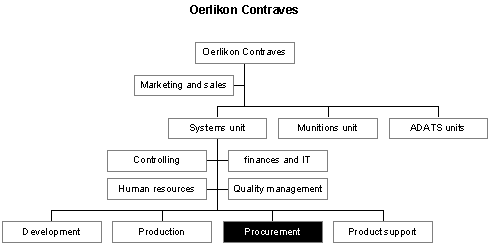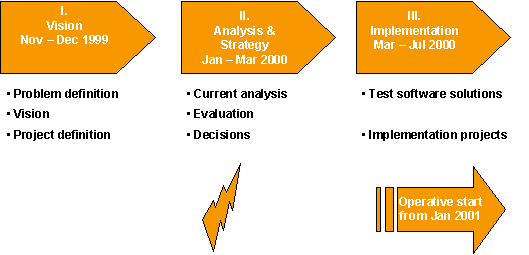Optimisation of procurement of C articles at Oerlikon Contraves Defence AG
Oerlikon Contraves Defence AG, part of the Rheinmetall Group, is active in the fields of systems, ammunition and the ADATS air defence missile system. The object of this case study is procurement in the Systems division. Potential for optimisation in procurement of C articles was diagnosed. Procurement should now be optimised by means of a business-to-business procurement system with regard to time and cost outlay for small orders.
1. The company
Oerlikon Contraves Defence AG (referred to as Oerlikon Contraves below), is part of the Rheinmetall Group and is active in the fields of systems, ammunition and ADATS (anti-aircraft missile system). Its key figures in 1999 were turnover of CHF 7 billion and 33,000 employees. Oerlikon Contraves is market leader in cannon-based defence systems against low-flying aircraft and also supplies guided weapons and combined systems. Oerlikon Contraves develops and manufactures missile guidance systems, ordnance and ammunition. It can thus offer complete one-stop systems worldwide. Its systems have been introduced in over 40 countries. Other areas of activity are vehicle armaments, naval air defence, simulators and training systems as well as electronic battlefield identification.

Fig. 1: Organisational form of Oerlikon Contraves (simplified representation).
Oerlikon Contraves employs some 2,100 persons, 1,300 of whom are based in Switzerland. In 1998 turnover of CHF 504 million was generated, 80% of it abroad (Asia, Europe and South America).
This case study covers the procurement section of the Systems division. Thirty or so people work in the procurement department, making around 7,000 orders a year with some 17,000 ordered items and a total order value of approx. CHF 110 million. It is divided into five purchasing units.
- Services and investments
- Missile guidance systems and electronic components
- Ordnance and mechanical parts
- Compensations, external services and training systems
- Group companies and repairs
The market volume is estimated at around CHF 25 billion and is expected to remain at this figure in the future. The market is dominated by five firms. Oerlikon Contraves is market leader in the one-stop complete systems segment.
2. Starting situation and project targets
An analysis in 1999 showed that 90% (in absolute terms: approx. 1,400) of all suppliers deliver C parts and thus generate only 10% of all sales turnover. Obviously, there is great potential for optimisation in this area. Once the stark imbalance between the number of suppliers and their share of turnover had been recognised, various annual targets were set for the procurement department.
The project target in the area of E-Procurement was: “With the aid of a business-to-business procurement system, costs and time for small orders will be minimised without loss of control.” It was hoped that the results of this project would represent a well-founded basis for decisions in creating an ideal procurement concept.
The entire project roughly comprises three phases (see Fig. 2):

Fig. 2: Project progress (project phases)
3. Analysis of the current situation
(a) Analysis of article structure: Since Contraves’ products are highly complex, relatively large systems that require a multitude of small parts, it is not surprising that 72% of all articles bought in 1998 and 1999 had a value of less than CHF 1,000. This large proportion, however, makes up just 3.05% of the entire procurement volume (value). Articles costing less than CHF 100 per unit make up 31% of all purchased articles yet generate only 0.24% of purchase volume values.
(b) Analysis of orders aided by an ABC analysis: The ABC analysis for 1998 provided interesting reading: the share of orders for A parts is just 2.5% of all orders. B materials make up around 12.5% and C materials 85% of all orders.
(c) Analysis of suppliers: A detailed analysis of suppliers revealed that 65% of all suppliers (in absolute terms: approx. 1,000) generate annual turnover of less than CHF 10,000 with Oerlikon Contraves. More than 85% of suppliers achieve annual turnover of below CHF 50,000. This reflects and confirms the article and order analyses. Many low-value orders are placed with various suppliers.
(d) Analysis of existing procurement processes: The following procurement processes are used at Oerlikon Contraves:
- Procurement using the standard business software SAP R/3.
- Procurement using written purchase requisitions.
- Procurement using the VISA Purchasing Card
- Procurement using online catalogues at selected suppliers (sell-side solution).
Lead times are between 10 and 15 days, with the greatest time spent in idle storage. A fifth procurement process is represented by partial outsourcing based on the Kanban principle. This system greatly reduces the workload of the procurement department.
(e) Analysis of costs: A rudimentary cost analysis carried out in 1998 found average costs of CHF 275 per order. It should be noted that large, segment-specific differences exist between the departments (procurement of a replacement parts for a 20-year-old component as opposed to procurement of a commercially available laser printer).
4. Recommendations for action
(a) General findings and recommendations: It can be clearly stated that an extremely large potential for optimisation exists at Oerlikon Contraves, especially in the area of C materials. Orders of C materials predominate at present. The introduction of an E-Procurement solution is particularly suited to this area. It would enable huge savings to be achieved in lead times and on the cost side.
The E-Procurement solution to be introduced must be a system that covers the entire procurement process from start to finish so that no data has to be entered twice. The entire process must be optimise. Only this way can far-reaching improvements be achieved.
Care must moreover be taken when selecting the E-Procurement solution to ensure that the system is upgradeable since it is anticipated that A and B parts will be traded over the internet in the longer term.
The future of the VISA Purchasing Card in the company is debatable. The fact is that not every employee currently has access to a PC; a telephone is available to all, however, and thus continued ordering by VISA Purchasing Card would appear to be justified. However, by concentrating on one solution, i.e. an E-Procurement system, uncertainties, loopholes and recording faults could be eliminated and the best optimisation results achieved.
(b) Process redesign: The process has shifted from the central purchasing to the user. The user orders directly from the supplier via the system. The task of the purchasing department is now to concentrate on the suppliers and create particularly good procurement terms through skilful purchase negotiations.
(c) Elimination of superfluous controls: Out of nine main process steps, four are currently exclusively for control. The user’s superior determines whether there is an actual requirement for the order and whether correct internal ordering procedures have been followed. The purchasing department checks again whether everything has been filled out correctly. Finally, incoming goods and the user check the order once again. The whole process is repeated by accounting.
A far-reaching transculturation in the sense of “trust instead of control” has to be introduced. That does not mean that checks are no longer made at all; rather, the checks are undertaken by the system and the user. This naturally presupposes reconsideration of the company’s signature policy and the readiness to support this culture change and contribute actively to its success.
This demand is accompanied by increasing decentralisation in purchasing. Local purchasing already takes place in the branches in Germany, Italy, Malaysia and Singapore. The “leading house” in Zürich supports decentralised procurement by optimising processes, creating synergies, consolidation and by pooling purchasing power. In this sense, strategic procurement should fall to Zürich (e.g., selecting and stipulating suitable suppliers).
(d) User empowerment: The aim is to empower the user to process the order from a defined shopping basket directly with the supplier. This means that the user places the order with the supplier and thus orders the goods directly. Based on the evaluated delivery notes (which contain price information), users or the incoming goods department can execute a simplified control of accounts.
The aim of user empowerment is to reduce the chain of communication and cultivate the corporate philosophy. An absolute prerequisite for successful empowerment of the user is the provision of a simple, clear and convenient order medium. In addition, buyer’s qualification must be raised; training and communicating the knowledge needed to use IT systems must be improved.
(e) Development of system partnerships with certain suppliers: As already mentioned, the business processes to be redesigned should also extend beyond the ambit of the company (business network redesign). The aim must be to develop close cooperative relationships with “preferred suppliers”. For strategic considerations, a reduction of and a concentration on suitable suppliers must ensue.
Considering that at Oerlikon Contraves 65% of all suppliers (approx. 1,000) generate annual turnover of below CHF 10,000, consolidation must take place. There are several reasons for this. With such small volumes, purchasing power cannot be properly exercised meaning that beneficial procurement terms cannot be achieved for the company and means that maintaining supplier contacts entails high expense and work. It would also be feasible to pool purchasing power in cooperation with other companies.
Even if this appears difficult at first, concentration on selected suppliers must take place. Only this way can better terms and thus better purchasing results be achieved in the long term. The number of C article suppliers must be reduced.
5. Future perspectives
The findings derived from the analysis of the current situation carried out in the five sections continue to clearly show that huge potential for optimisation exists in the C materials area. The areas of optimisation have been pinpointed. Now a swift decision needs to be taken to introduce an E-Procurement solution to create strategic advantages over the competition and enable appreciable improvements and simplifications to take effect internally.
Above all the realisations gained from the rapid global increase in electronic commerce in the business-to-business area should be taken into account in selecting a suitable E-Procurement solution in ensuring that it is multi-extensible. The use of tenders is in evaluation.
The example of Oerlikon Contraves Defence AG presents a typical starting situation for many companies. Nevertheless, several special features are evident: on the one hand, the company’s specialised customers, on the other, the extremely long useful life of its systems which are by and large specific customer solutions. The result are small job lots, no constant demand and thoroughly unpredictable parts demand.
New potential through an E-Procurement solution is being targeted, however, although it should be borne in mind that today’s market practically only offers solutions for MRO products and indirect goods and not for production material


